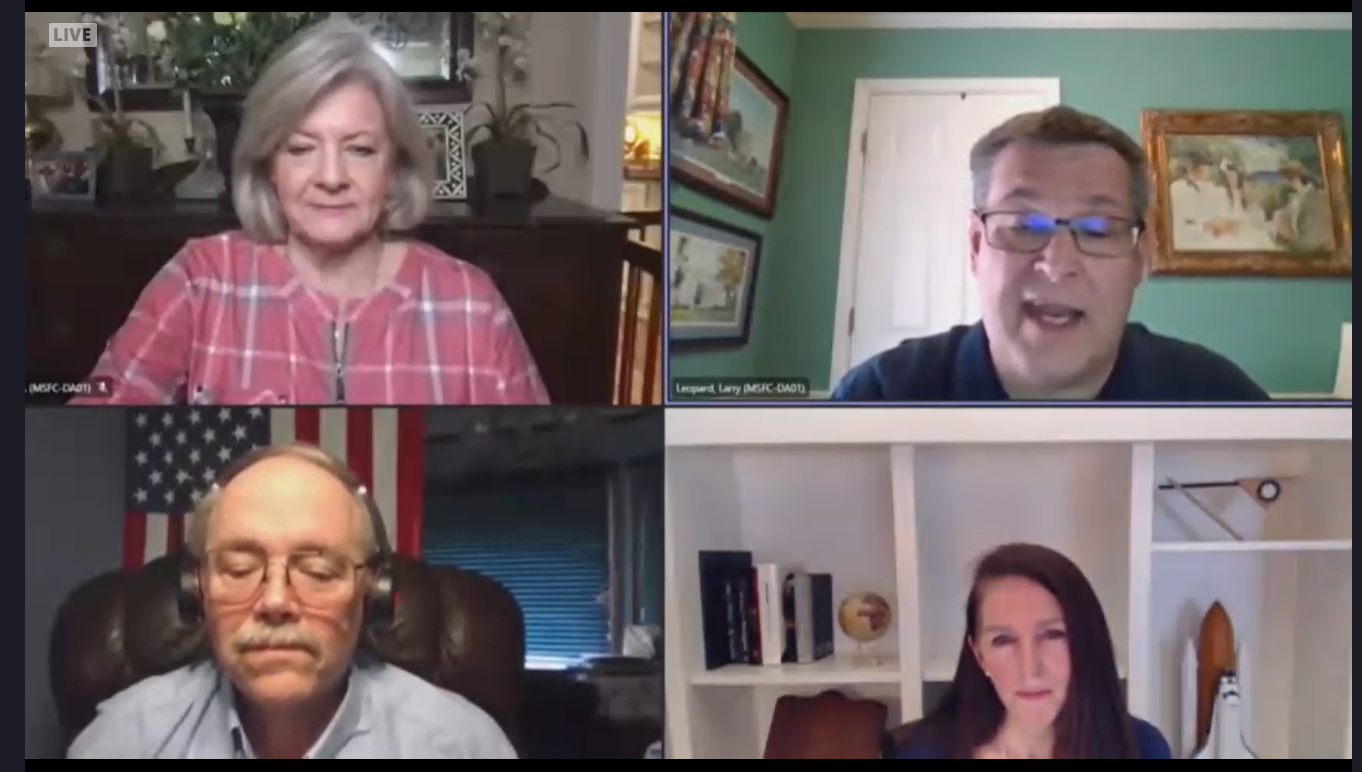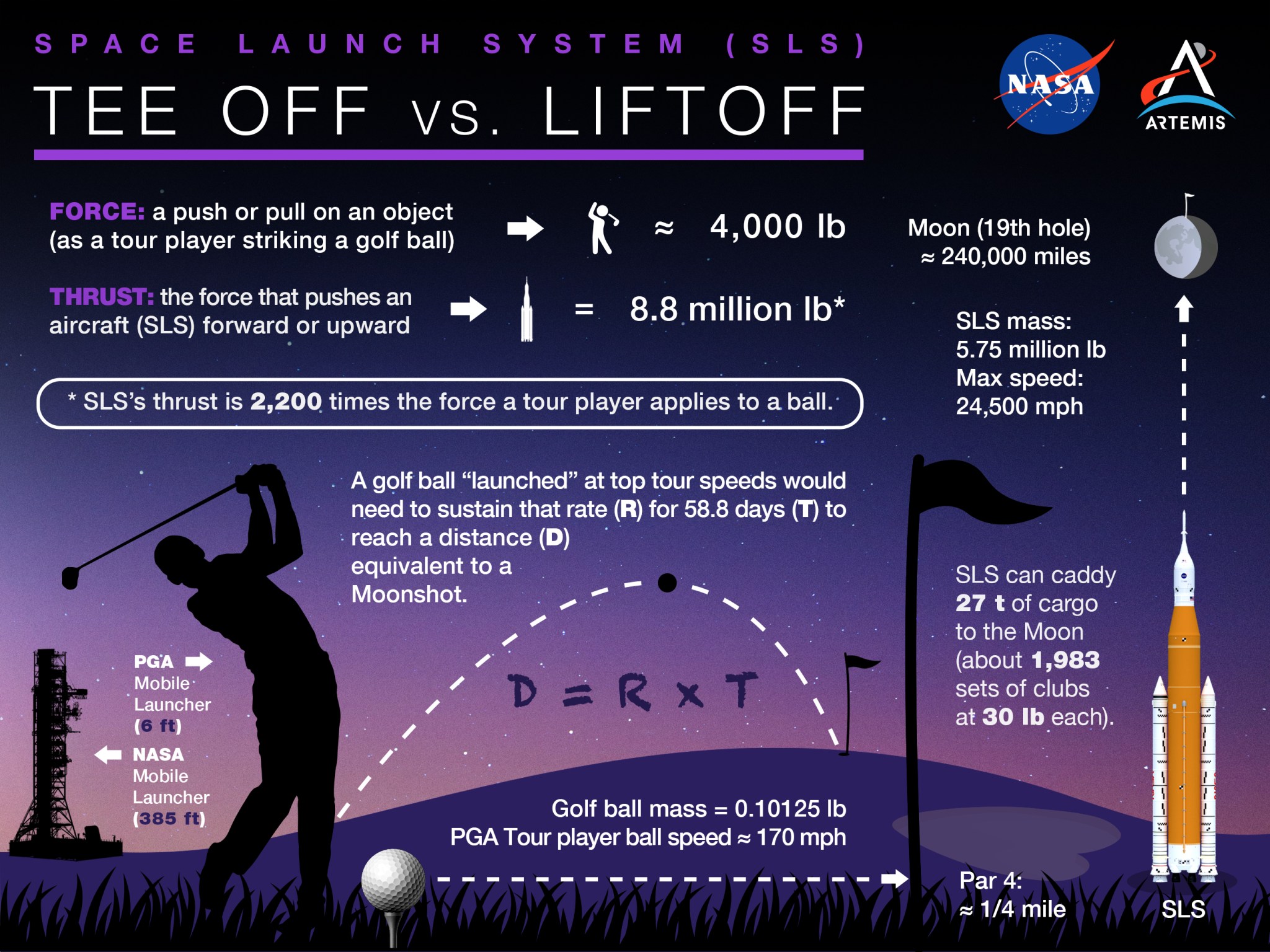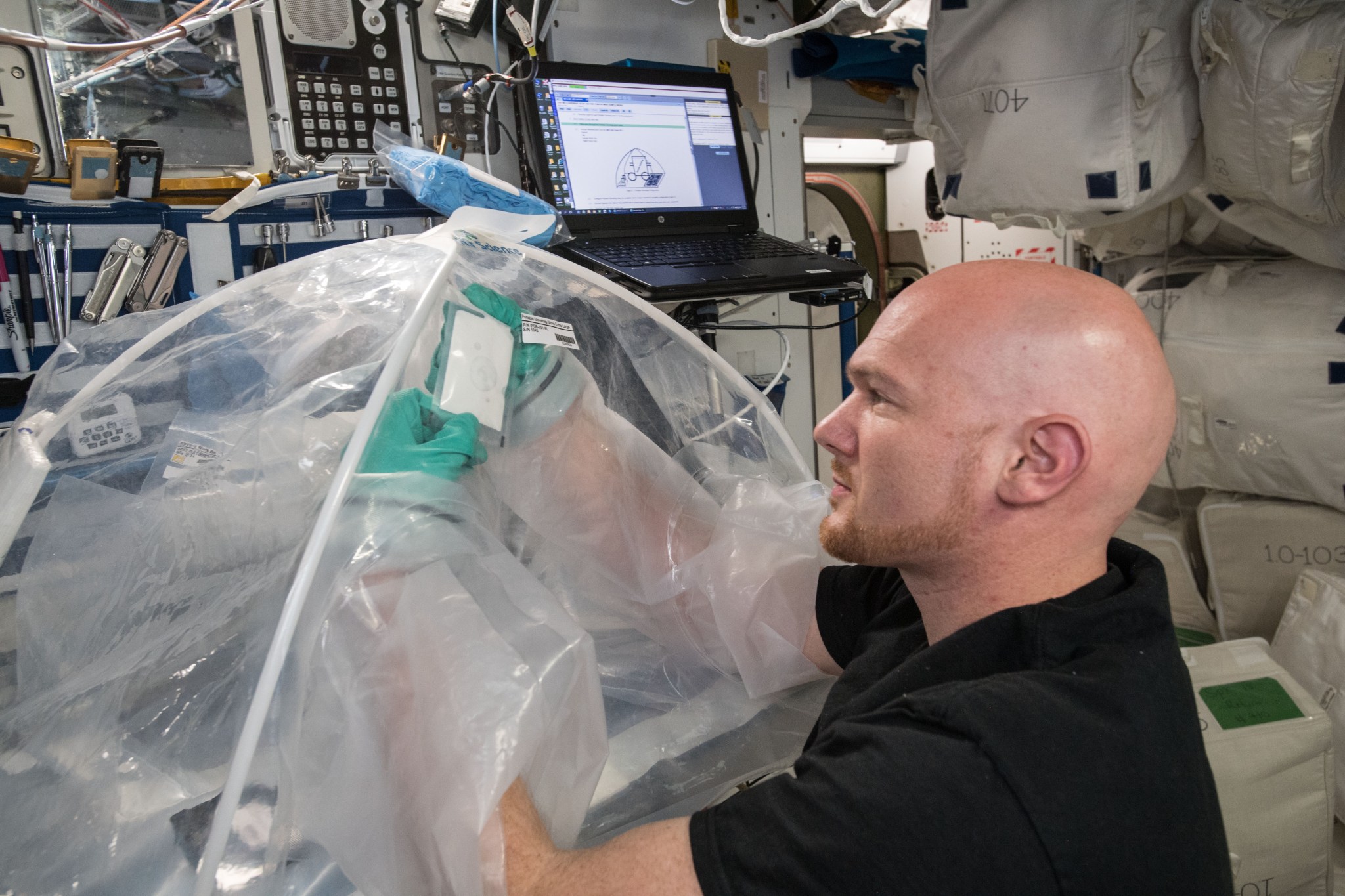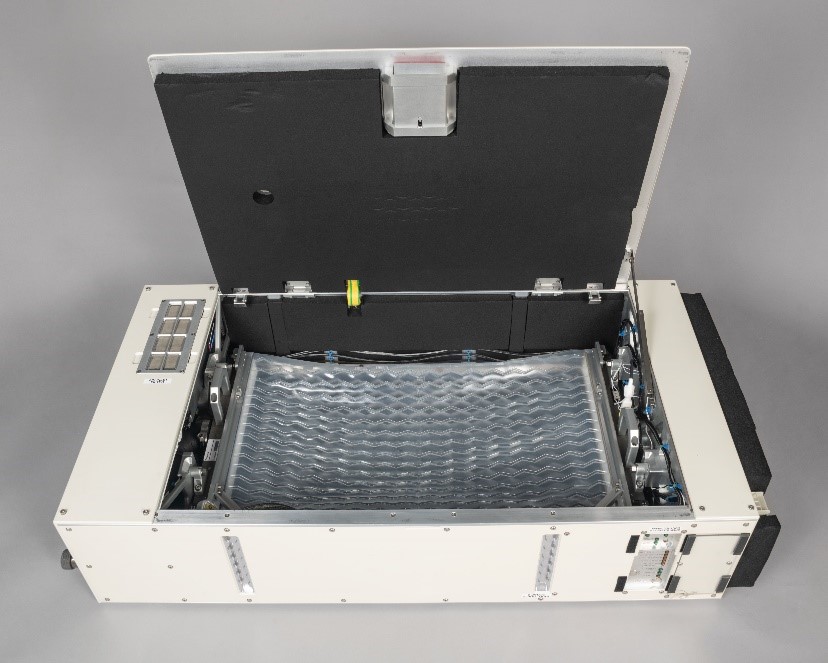In This Week’s Star
- Marshall Leaders Look Ahead to 2022 in All-Hands Meeting
- Flags Retired from Building 4200; New Flags Raised at Building 4221
- NASA Honors Fallen Heroes with Day of Remembrance; Singer, Hill Deliver Marshall Tribute
- Did You Know the Artemis I SLS Can Caddy 27 Tons of Cargo to the Moon?
- Five Space Station Research Results Contributing to Deep Space Exploration
- Webb Reaches New Home, Highlighted on ‘This Week at NASA’
Marshall Leaders Look Ahead to 2022 in All-Hands Meeting

Leaders of NASA’s Marshall Space Flight Center listen as Associate Director, Technical, Larry Leopard, top right, reads a question during the first all-hands meeting of the new year in a live virtual address Jan. 31. The leaders discussed recent accomplishments, continuing to work through the COVID-19 pandemic, and the future of work before answering questions submitted by team members. Marshall Director Jody Singer, top left, discussed Marshall leadership changes, including welcoming new Associate Director Rae Ann Meyer, bottom right. Singer highlighted ongoing work with NASA’s Space Launch System (SLS), as well as support Marshall provides for the Human Landing System, the International Space Station, and other science and technology missions. “It is amazing when you see dreams become reality,” Singer said. “We’re approaching the first launch of SLS with the Artemis I mission, and it’s only possible because of what you have done. It’s such an important part of writing the next chapter of history.” Deputy Director Rick Burt, bottom left, discussed milestones reached for the Imaging X-ray Polarimetry Explorer, the James Webb Space Telescope, and the Commercial Crew Program, each of which have significant contributions from Marshall. Meyer spoke about telework and team members remaining flexible while continuing to navigate the pandemic. She said discussions continue about the future of the center’s work environment. “I know it can be frustrating to be continually disrupted by COVID, and your safety remains our priority,” Meyer said. (NASA)
Flags Retired from Building 4200; New Flags Raised at Building 4221

The U.S. and NASA flags atop Building 4200, left, Marshall Space Flight Center’s original central laboratory and office building, were retired Jan. 21. Building 4200 served as Marshall’s headquarters from 1963 to 2021, when it was decommissioned. A flag-raising ceremony marking the transfer of Marshall headquarters to Building 4221, right, was held Jan. 26. The doors to Building 4221 opened on Earth Day, April 22, 2019. (NASA/Danielle Burleson)
NASA Honors Fallen Heroes with Day of Remembrance; Singer, Hill Deliver Marshall Tribute
Jody Singer, director of NASA’s Marshall Space Flight Center, and Bill Hill, Marshall’s director of Safety and Mission Assurance, remember agency family members lost in the pursuit of space exploration on NASA’s Day of Remembrance, Jan. 27. “The fallen from Apollo 1, Challenger, and Columbia all have places forever in our hearts and are solemn reminders of what is at stake. With risk comes the responsibility to honor what we lost, but also to learn from the mistakes of the past.” Singer said. This year’s Day of Remembrance marks 55 years since the Apollo 1 tragedy. “We all realize that our astronauts work in a very unforgiving environment, but we strive to minimize the risk imposed on them as they work in space and soon on the surface of the Moon,” Hill said. NASA hosted virtual ceremonies at Arlington National Cemetery in Virginia, and the agency’s Kennedy Space Center and Johnson Space Center, as well as a panel discussion on the topic of safety and lessons learned from the agency’s tragedies. (NASA)
Did You Know the Artemis I SLS Can Caddy 27 Tons of Cargo to the Moon?

There are similarities between launching a golf ball and sending NASA’s Space Launch System (SLS) rocket on its debut Artemis I mission. A rocket must overcome the laws of physics to make it to space. SLS will head to space with a maximum power of 8.8 million pounds of thrust, making it the world’s most powerful rocket and the only rocket capable of sending the Orion spacecraft to the Moon on a single mission. With Artemis missions, NASA will land the first woman and the first person of color on the lunar surface and establish long-term exploration at the Moon in preparation for human missions to Mars. SLS and Orion, along with the human landing system and the Gateway in orbit around the Moon, are NASA’s foundation for deep space exploration. Over the years, NASA has contributed technology and innovation to the sport of golf. (NASA)
Five Space Station Research Results Contributing to Deep Space Exploration
More than 3,000 experiments have been conducted aboard the International Space Station during the 21 years humans have been living and working in space. These experiments have provided insights helping improve life back on Earth and explore farther into the solar system. Researchers have shared these results in thousands of scientific publications.
The Payload Operations Integration Center at NASA’s Marshall Space Flight Center oversees all experiments and science communications aboard the station. It is staffed around the clock, 365 days per year.
Here are some of the important new discoveries and inventions made thanks to space station research and technology demonstrations:
Closing the water loop for exploration: Future deep space exploration missions will require spacefarers to have a nearly self-contained water system in which they can recover, recycle, and reuse more than 98% of the water loaded aboard their spacecraft from the beginning of their mission. The Urine Processor Assembly, part of the station’s environmental control and life support system, can achieve close to 94% recovery, but some water remains in the brine waste product after urine is processed, and that water has potential to be recovered. The new Brine Processor Assembly is a technology demonstration system that is now recovering that water on station.
The Brine Processor Assembly technology demonstration has completed five de-watering cycles. Bladders from these operational runs are planned to return to Earth on the SpaceX Dragon capsule and will be analyzed to confirm assembly efficiency. All indications from in-orbit telemetry are that the assembly is functioning as intended.
Paragon Space Development Corporation of Tucson, Arizona, developed the assembly in cooperation with Marshall and NASA’s Johnson Space Center.
Mixing cement in space to learn to construct Moon bases: Lunar regolith simulant (JSC-1A), mock lunar soil that emulates the properties of material from the Moon, has been used to create metals, glasses, and cement on Earth. The Microgravity Investigation of Cement Solidification study conducted aboard the station recently published results examining JSC-1A for its potential use as a lunar construction material. Researchers found a fine portion of lunar soil simulant can be used as a cement supplement, a coarse portion can be used as filler, and that mixing the lunar regolith simulant, cement, and water results in a hardy mortar. These results indicate it might be feasible to use lunar dust as a material for building lunar bases.

The Redwire Regolith Print study launched aboard the Northrop Grumman Cygnus on its 16th commercial resupply services mission builds on these results, using a JSC-1A /polymer mixture to see if regolith can be used for 3D printing to study the feasibility of printing structures on the Moon or Mars. Marshall’s Christopher Roberts, Tracie Prater, and Alex Blanchard are collaborators on the Redwire study.
The study also investigated the effect of microgravity on the reaction that occurs when cement and water are mixed together. Results recently published in ScienceDirect showed that the cement mixed in space had a microstructure marked by long lines and more trapped air than cement created on Earth. By learning this aboard the space station, scientists can better anticipate the strength of cement structures in space, and the results will contribute to the development of new materials for the construction of extraterrestrial habitats.
A new way to grow plants in space: The Passive Orbital Nutrient Delivery System is a newly patented plant growth approach that was tested aboard the station to water plants both in Earth’s gravity and microgravity. The system provides reliable water delivery to seeds, transports water from a reservoir, and provides nutrients and aeration to roots. The system is passive, meaning it operates with no electricity, no pumps, and no moving parts. On future deep space missions, astronauts could use this method to grow fresh vegetables to supplement their diet as they venture deeper into space.
Communicating back home: SOLISS, a small Japan Aerospace Exploration Agency communication terminal attached to the station, was tested for its laser pointing accuracy. The SOLISS team published their results detailing how they succeeded in establishing a bidirectional optical Ethernet link between low-Earth orbit and the ground. This technology transmits information faster than ever before, potentially supporting Earth’s needs while supplying needed capabilities as humans travel farther from Earth.
Studying effects of space radiation on fertility: The Space Pup experiment sent mouse sperm samples to the station and returned the samples to Earth at different times, first at nine months, then two years and nine months, and finally after 5 years and 10 months – the longest time period any samples have been preserved in station biological research. The intent was to determine the effects of space radiation on DNA mutations. New results published in Science Advances from the experiment indicate that space radiation did not affect mouse sperm DNA or fertility and yielded normal offspring on Earth with the same success rate as ground controls.
Sustaining life beyond Earth either on space stations or other planets requires a clear understanding of how the space environment affects mammalian fertility. Before this experiment, only non-mammalian reproductivity had been studied in space.
Webb Reaches New Home, Highlighted on ‘This Week at NASA’
NASA’s James Webb Space Telescope reached its final science destination and is featured in “This Week @NASA,” a weekly video program broadcast on NASA-TV and posted online.
On Jan. 24, the Webb team commanded the spacecraft to make a planned mid-course correction burn that placed it into its final orbit around the second Sun-Earth Lagrange point, or L2. From this vantage point, the telescope will have a wide view of the cosmos and be able to perform optimal science. It will be several more months before the observatory’s optics and systems are ready to begin science operations. Webb, the world’s largest, most powerful, and most complex space science telescope ever built, will reveal new and unexpected discoveries and help humanity understand the origins of the universe and humanity’s place in it.
The Webb team at NASA’s Marshall Space Flight Center spent more than two decades working on the telescope, primarily focusing on development and testing of the mirrors in extreme cold temperatures at which Webb operates..
View this and previous episodes at “This Week @NASA” on NASA’s YouTube page.


























